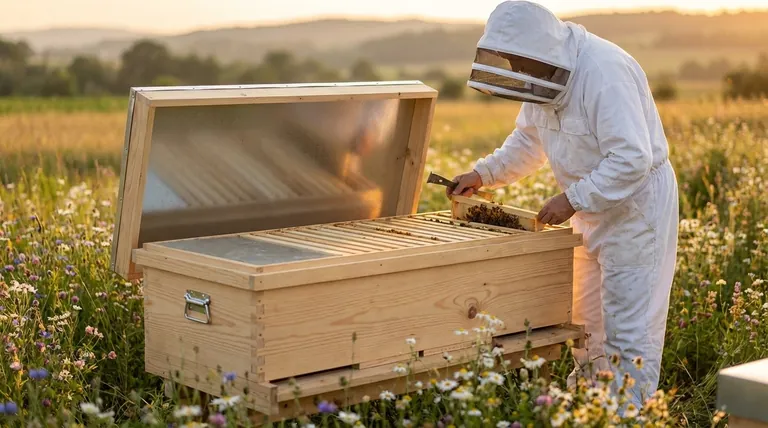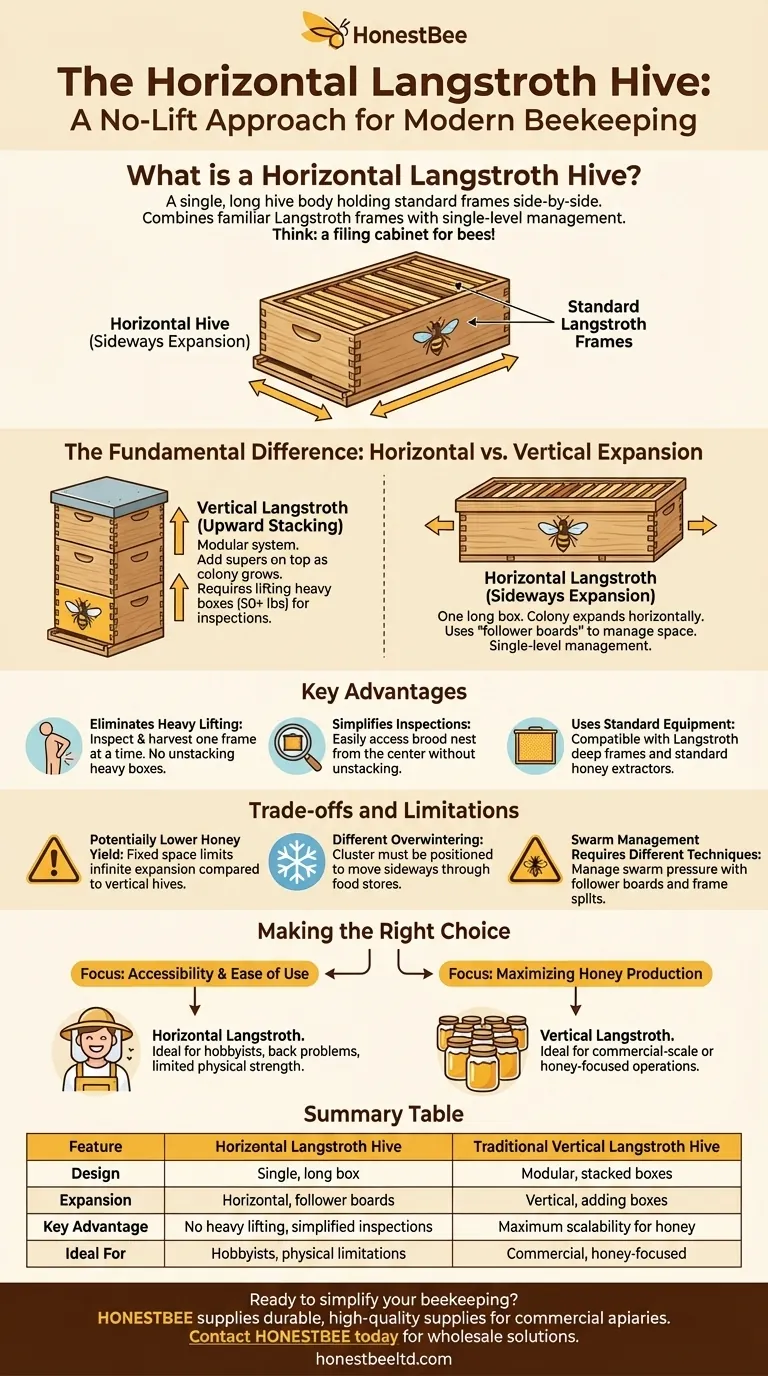At its core, a horizontal Langstroth hive is a single, long hive body that holds standard Langstroth frames side-by-side rather than in vertically stacked boxes. It functions like a standard hive turned on its side and stretched out, allowing beekeepers to manage the colony without ever lifting heavy boxes full of honey. This design combines the familiar, standardized frames of a Langstroth with the single-level management of a top-bar hive.
The central decision between a horizontal and a vertical Langstroth hive is a trade-off. You are choosing between the single-level, no-heavy-lifting convenience of a horizontal hive and the maximum vertical scalability and honey production potential of a traditional stacked hive.

The Fundamental Difference: Horizontal vs. Vertical Expansion
The primary distinction between these two hive types is the direction in which the bee colony expands. This single difference dictates every aspect of how you will manage the hive.
How a Standard Langstroth Works: Vertical Stacking
A traditional Langstroth hive is a modular, vertical system. The queen lays eggs in the "brood box" at the bottom.
As the colony grows and needs more space for honey, the beekeeper adds boxes, called "supers," on top. This means inspections and harvests require unstacking and lifting boxes that can weigh over 50 pounds (23 kg) each.
How a Horizontal Langstroth Works: Sideways Expansion
A horizontal Langstroth consists of one long box that may hold 20 or more frames. The brood nest is typically established in the center.
As the colony expands, the bees store honey in the frames on either side of the brood nest. The entire colony is on one level, more like a filing cabinet for bees. Expansion is managed horizontally using "follower boards," which are movable dividers.
Key Advantages of the Horizontal Design
Choosing a horizontal hive is a deliberate choice for a specific management style, primarily centered around accessibility and ease of use.
Eliminates Heavy Lifting
This is the most significant benefit. You inspect and harvest one frame at a time. You never have to lift a heavy super full of honey, making it ideal for beekeepers with back problems or limited physical strength.
Simplifies Inspections
To inspect the brood nest, you simply open the lid and remove frames from the center. There is no need to unstack multiple heavy boxes to reach the bottom of the hive, making routine checks faster and less disruptive to the bees.
Uses Standard Langstroth Equipment
A critical advantage is that horizontal hives are built to use standard Langstroth deep frames. This means your frames are compatible with standard honey extractors, and you can easily share frames of brood or honey with standard vertical hives.
Understanding the Trade-offs and Limitations
The convenience of the horizontal design comes with trade-offs that are important to understand.
Potentially Lower Honey Yield
Because the hive has a fixed horizontal limit, it cannot be expanded indefinitely like a vertical hive. While it can produce plenty of honey for a hobbyist, a vertical hive stacked high will almost always have a greater potential for a massive single-season honey crop.
Different Overwintering Strategy
In a vertical hive, the bee cluster naturally moves upward through their honey stores as winter progresses. In a long horizontal hive, you must ensure the cluster is positioned to one side so they can move horizontally across their food stores throughout the winter.
Swarm Management Requires Different Techniques
In a vertical hive, you can easily split the colony by separating the boxes. In a horizontal hive, you must manage swarm pressure by carefully providing space with follower boards and performing splits by removing individual frames of brood to a new hive.
Making the Right Choice for Your Beekeeping Goals
The "best" hive is the one that aligns with your physical abilities, time commitment, and beekeeping philosophy.
- If your primary focus is accessibility and ease of management: The horizontal Langstroth is an outstanding choice that removes the greatest physical barrier to beekeeping—heavy lifting.
- If your primary focus is maximizing honey production or commercial-scale beekeeping: The traditional vertical Langstroth remains the industry standard for its proven scalability and efficiency.
Ultimately, understanding the core design trade-offs empowers you to select the right tool for your specific beekeeping journey.
Summary Table:
| Feature | Horizontal Langstroth Hive | Traditional Vertical Langstroth Hive |
|---|---|---|
| Design | Single, long box; frames side-by-side | Modular, stacked boxes (supers) |
| Expansion | Horizontal, managed with follower boards | Vertical, by adding boxes on top |
| Key Advantage | No heavy lifting; simplified inspections | Maximum scalability for honey production |
| Ideal For | Hobbyists, beekeepers with physical limitations | Commercial-scale or honey-focused operations |
Ready to simplify your beekeeping?
If the no-lift, accessible design of a horizontal Langstroth hive aligns with your goals, HONESTBEE is your partner. We supply durable, high-quality beekeeping supplies and equipment to commercial apiaries and distributors through our wholesale-focused operations.
Contact HONESTBEE today to discuss how our hive components and equipment can support your operation's efficiency and success.
Visual Guide

Related Products
- Langstroth Bee Hives Bee Keeping Box for Beginners Beekeeping
- HONESTBEE Advanced Ergonomic Stainless Steel Hive Tool for Beekeeping
- Long Langstroth Style Horizontal Top Bar Hive for Wholesale
- HONESTBEE Professional Long Handled Hive Tool with Precision Cutting Blade
- Wholesales Dadant Size Wooden Bee Hives for Beekeeping
People Also Ask
- How does the ease of access differ between 8-frame and 10-frame hives? Choose the Right Hive for Your Body
- What are the key features of the Langstroth beehive? A Guide to the Standard for Modern Beekeeping
- How does the orientation of the hive sides benefit comb construction? Ensure Straight, Movable Combs for Easier Hive Management
- What is the best type of bee hive for beginners? Start with the Proven Langstroth Standard
- Should a beginner try a different type of hive? Start with a Langstroth for a solid foundation.



















